After their flirtation with relegation to the Third Division in 1933/34, the following summer United strengthened with the signings of players such as inside forward George Mutch. After a difficult start to 1934/35, they soon went on to launch an unlikely promotion campaign. A run of eight successive wins put United in second place by mid November and by January they were still in the running. They even managed to get past their first opponents in the FA Cup (Bristol Rovers) but were knocked out by Nottingham Forest after a replay in the next round. After that, their league form deteriorated and United won only 6 out of their remaining 16 fixtures and could only finish in 5th place. Still, this was Scott Duncan's best finish to date and a marked improvement on the previous season.
The kits appear to have reverted to how they were at the start of the previous season - red was first choice and the hoops were retained as change strips.
The team photographed in change kits before the away game at Port Vale in September 1934:
The kits appear to have reverted to how they were at the start of the previous season - red was first choice and the hoops were retained as change strips.
The team photographed in change kits before the away game at Port Vale in September 1934:
The 1935/36 season was in many ways the mirror opposite of that which it followed. League form during the first half of the season was patchy and again United were knocked out of the cup after a fourth round replay. However, this time around the Reds were galvanised and went on an unbeaten run until the end of the season. A draw against Hull on the final day was enough to clinch the Second Division Championship and promotion back to the top flight after five years.
Crowds had also risen at Old Trafford during the season - in part due to this reversal of fortunes, but also because James Gibson had a platform built along the train track opposite the Main Stand to allow supporters easy access to the ground. Old Trafford Halt station still operates every match day.
Crowds had also risen at Old Trafford during the season - in part due to this reversal of fortunes, but also because James Gibson had a platform built along the train track opposite the Main Stand to allow supporters easy access to the ground. Old Trafford Halt station still operates every match day.
The United team were photographed in two different variations of their kits during 1935/36. One is the same as worn in previous seasons while the other has socks with red turnovers and white hoops:
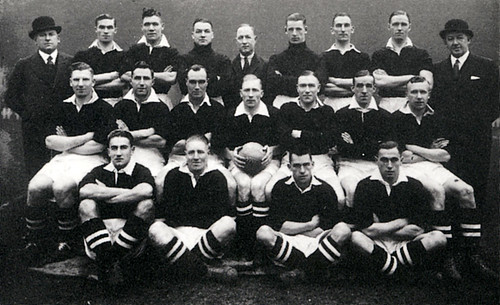
The return to the First Division was always going to be difficult for United, especially as they had failed to properly strengthen their team in the preseason, but it would have been reasonable to expect a little more fight from the team in 1936/37. With only three wins before Christmas it was a certainty that they would be struggling for survival come May.
The United team photographed in the spring of 1937 (the very odd looking player on the far left of the bottom row is recent signing George Gladwin, an outside half):
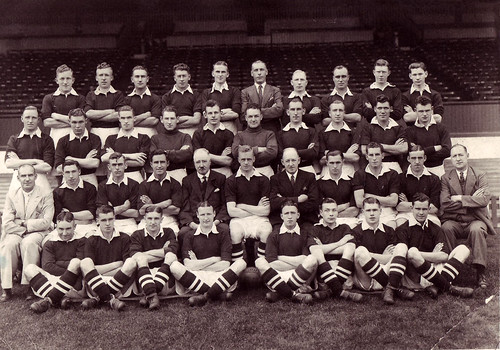
This is an edited version of an image from the extensive Leslie Millman collection, which can be found at www.flickr.com/photos/manchesterunitedman1/ and is used with full permission.

This is an edited version of an image from the extensive Leslie Millman collection, which can be found at www.flickr.com/photos/manchesterunitedman1/ and is used with full permission.
Frustratingly, two of those wins had been against a couple of the strongest sides in the country. A 3-2 derby win against eventual champions City in front of a record 68,796 crowd and a 2-0 victory over Arsenal were the highlights of a the season. Arsenal had revenge by knocking United out of the cup - again in the fourth round.
On the final day of the season an away loss to West Brom sealed United's fate - relegation to the second division, while Manchester City celebrated winning their first ever league title.
On the final day of the season an away loss to West Brom sealed United's fate - relegation to the second division, while Manchester City celebrated winning their first ever league title.
United's FA Cup defeat at Highbury was filmed for a newsreel and the players were wearing different change kits than in previous seasons. The new, thinner-hooped jerseys were presumably in the same colours of cherry and white while the shorts were dark - probably black:
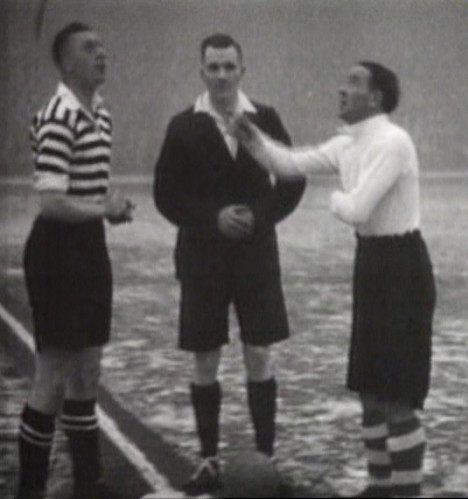
Although I currently have no photographic or written evidence, I believe United retained these change kits (at least) up until the outbreak of WWII. They would probably also have worn the jerseys with white shorts:
Although 1936/37 was a failure, groundwork had begun that would stand United in good stead in the following years. Young players such as Johnny Carey and Charlie Mitten had been scouted by Louis Rocca and signed up in early 1937. Early into 1937/38, James Gibson himself spotted a promising talent in 17 year old striker Jack Rowley while staying at his holiday home in Bournemouth where Rowley had been scoring freely for the local team, and quickly signed him for United. This most likely caused friction between the chairman and the manager Duncan, who quit the Reds shortly afterwards. Again, Walter Crickmer was handed the managerial reigns on a temporary basis. This arrangement would last until the end of the Second World War.
United's form throughout the season was again inconsistent, but a final day home win against Bury saw them finish second - just above Sheffield United on goal average - to secure immediate promotion. The Cup campaign had been a slight improvement as United reached the fifth round only to be knocked out by Brentford. Meanwhile, United's rivals at Maine Road became the only side to win the Championship one season only to be relegated the next! For the second time in forty years, the fortunes of Manchester's two great clubs had been reversed.
Meanwhile, Gibson had been working hard behind the scenes towards his dream of building an all-Mancunian team at United and the MUJAC (Manchester United Junior Athletic Club) was founded with a home found for them at The Cliff on Lower Broughton Road in Broughton, Salford which had formerly been home to Broughton Rangers rugby league club. Young players such as John Aston and Johnny Anderson who would form the core of the post war team had already begun their journey which would lead the Club to greatness and glory in the coming years.
Meanwhile, Gibson had been working hard behind the scenes towards his dream of building an all-Mancunian team at United and the MUJAC (Manchester United Junior Athletic Club) was founded with a home found for them at The Cliff on Lower Broughton Road in Broughton, Salford which had formerly been home to Broughton Rangers rugby league club. Young players such as John Aston and Johnny Anderson who would form the core of the post war team had already begun their journey which would lead the Club to greatness and glory in the coming years.
Alex Howells, a contributor to unitedkits.com had a trawl through the archives at Getty Images and has uncovered an image of United Vs Arsenal at Highbury in 1939. The United player appears to be wearing a blue jersey:
The season was successful enough for United. While the junior and reserve sides won their respective leagues, again the first team struggled at times but after a fairly unspectacular and unremarkable First Division campaign, they finished in a respectable 14th place. One of the few points of note is that in November 1938, a 20 year-old Allenby Chilton became the last player (to date) to be transferred directly from Liverpool to United.
Chilton would have to wait almost 8 years to make his official league debut for United, as once again, Britain found itself at war with Germany and their allies and the league was abandoned.
Chilton would have to wait almost 8 years to make his official league debut for United, as once again, Britain found itself at war with Germany and their allies and the league was abandoned.


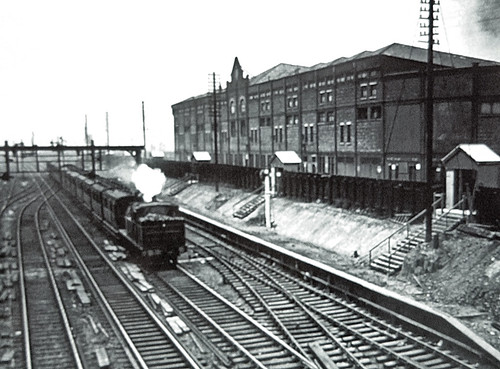
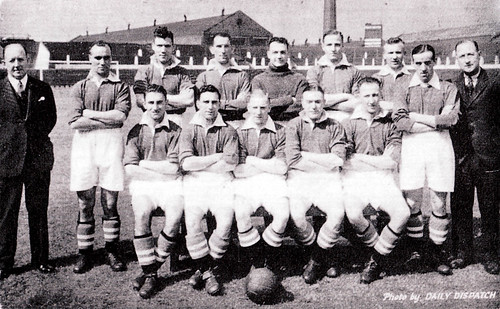
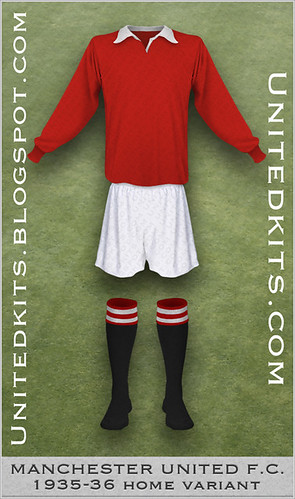

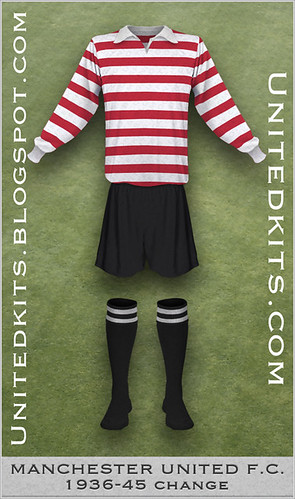
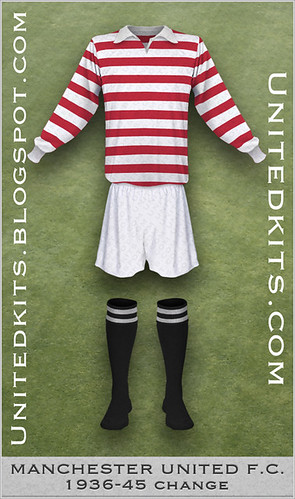
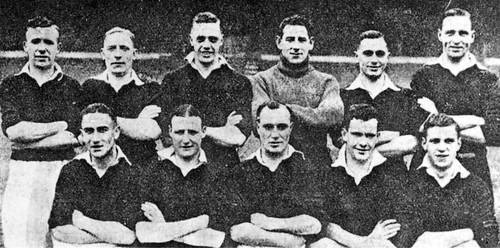

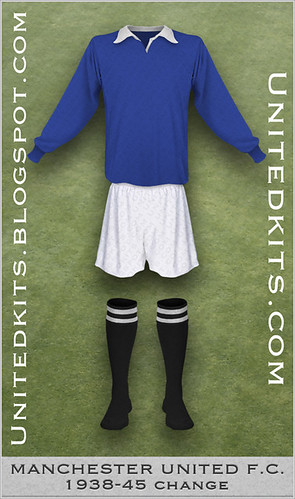
No comments:
Post a Comment